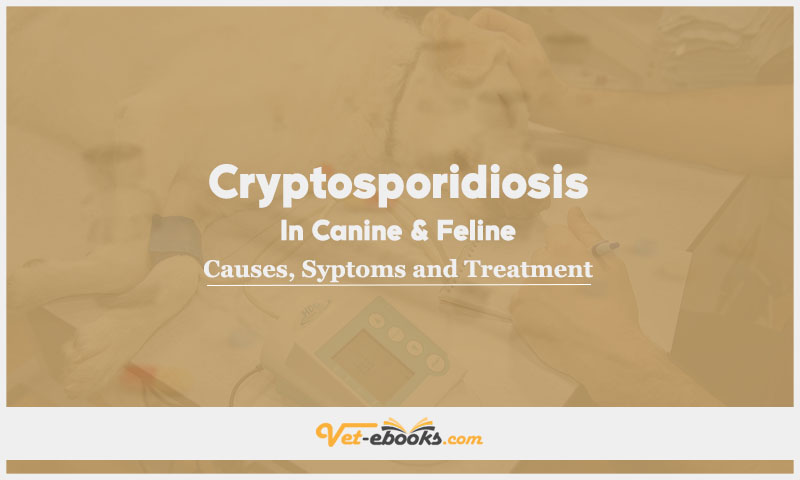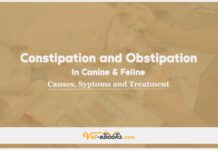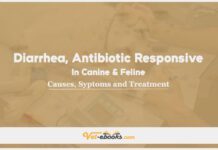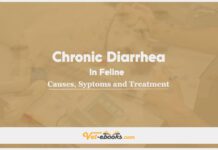Cryptosporidiosis In Canine and Feline: Causes, Symptoms and Treatment

Contents
hide
Overview
Cryptosporidiosis, which is induced by Cryptosporidium spp., is an apicomplexan protozoan responsible for gastrointestinal disorders. Immunocompetent animals primarily exhibit intestinal symptoms, whereas immunocompromised animals may experience a range of issues, including intestinal problems, as well as liver, gallbladder, pancreatic, and respiratory infections.
Causes of Cryptosporidiosis In Canine and Feline:
Causes and Risk factors:
- Several species of Cryptosporidium are known to exist, including (c.canis) and (c.felis).
- Certain species exhibit host specificity, while others, such as Cryptosporidium parvum, have the ability to infect multiple species.
- Cryptosporidium parvum is the primary species responsible for infecting small animals.
- Immunosuppression is a critical risk factor for Cryptosporidiosis, with common causes including feline leukemia virus, canine distemper virus, canine parvovirus, and intestinal lymphoma.
- In immunocompetent animals, infection typically proceeds asymptomatically, characterized by the shedding of fecal oocysts without any apparent clinical signs.
Pathogenesis of Cryptosporidiosis In Canine and Feline:
- Infection occurs by ingestion of sporulated oocysts then releasing sporozoites that penetrate intestinal epithelial cells. Following asexual reproduction, merozoites are released to infect additional cells. Subsequently, sexual reproduction occurs, leading to the shedding of oocysts.
- In cats, the prepatent period is typically 5 to 10 days.
Symptoms (History & Physical Examination) of Cryptosporidiosis In Canine and Feline:
History:
- There is no significant sex or breed predilection observed in either cats or dogs.
- In dogs, clinical cases are nearly exclusive to those aged less than 6 months.
- Older dogs can excrete cysts, but clinical signs typically only manifest when complicated by intestinal diseases like Inflammatory Bowel Disease (IBD) or neoplasia such as GI tract lymphoma.
- For cats in the United States, serologic examination results indicate an exposure rate of approximately 15%.
- Clinical cases in cats are predominantly reported in immunocompromised individuals.
- Cryptosporidiosis is more prevalent in young and newborn kittens, with the majority of cases occurring in those under 6 months of age
Physical Examination:
- Most commonly, Cryptosporidiosis results in asymptomatic oocyst shedding. However, in some cases, it may lead to small-bowel diarrhea, although instances of large-bowel diarrhea have also been reported.
Diagnosis of Cryptosporidiosis In Canine and Feline
1- From History and Physical Examination
2- Diagnostic Procedures
- Typically, standard diagnostic tests such as a complete blood count (CBC), biochemical panel, urinalysis, and imaging result normal unless influenced by an underlying disease process.
- The identification of Cryptosporidium oocysts in feces is usually achieved through sugar and zinc sulfate flotation methods, which have a specific gravity of 1.18. However, due to the organism’s small size(4-8 micrometers), oocyst identification can be challenging and is best performed by experienced laboratory staff.
- The preferred staining method for identifying Cryptosporidium oocysts is the modified acid-fast stain, which causes the oocysts to appear orange-red. This staining technique enhances visibility.
- Crystal violet staining will affect fecal material but not the oocysts, making the oocysts more easily distinguishable (known as negative staining).
- Direct fluorescent antibody kits like Merifluor (Meridian Diagnostics) are effective in cats and dogs but are typically available only in diagnostic laboratories.
- Antigen detection methods such as ProSpecT, Cryptosporidium Mitrotiter Assay (Alexon), and Color-Vue Cryptosporidium (Seradyn) are available and appear to be capable of detecting C. felis and C. canis.
- PCR techniques are available in some commercial laboratories and are about 10-100 times more sensitive for diagnosing cryptosporidiosis in cats compared to other techniques.
- Intestinal biopsy or cytology may reveal the presence of Cryptosporidium organisms within epithelial cells, but it can produce false-negative results in some cases.
3- Differential Diagnosis:
- Other parasitic infections such as giardiasis and trichuriasis.
- Infectious agents like parvovirus, coronavirus, feline infectious peritonitis, Salmonella, Campylobacter, Rickettsia, and Histoplasma.
- Metabolic issues such as hypoadrenocorticism and hyperthyroidism in cats.
- Infiltrative diseases, for example, inflammatory bowel disease and intestinal lymphoma.
- Dietary indiscretion or intolerance.
- Toxicities stemming from medications, lead exposure, and other substances.
Treatment of Cryptosporidiosis In Canine and Feline:
General :
- In immunocompetent animals, diarrhea caused by Cryptosporidiosis is typically very mild and tends to resolve on its own.
- It’s often advisable to wait for two weeks and then check for oocyst shedding again, unless there are significant public health or zoonosis concerns.
- If underlying diseases are present, they should be treated aggressively.
- In cases of mild diarrhea, outpatient treatment is usually sufficient. This may involve withholding food for 24-48 hours and supplementing with oral glucose-electrolyte solutions .
- For severe diarrhea, it’s recommended to withhold food (NPO) and provide parenteral fluids, usually isotonic fluids with added potassium (at least 30 mEq/liter). This approach helps manage more severe cases of diarrhea effectively
Medications:
- Paromomycin (Humatin®): the dose is 125-165 mg/kg orally every 12 hours for 5 days. This aminoglycoside has shown effectiveness in humans with acute intestinal symptoms.
- Tylosin : at a dose of 11 mg/kg orally every 12 hours for a duration of 28 days.
- Nitazoxanide (Alinia®) : the dose is 25 mg/kg orally once every 24 hours for a period of 7-28 days.
- Nitazoxanide can reduce oocyst shedding in cats, but it may be associated with vomiting so antiemetic treatment is recommended. it is used in a limited number of cats for Cryptosporidiosis management
Some Notes:
- Cryptosporidiosis caused by C. canis and C. felis is rarely transmitted to humans, and the risk of infection from pets to their owners is very low.
- While some studies indicate that the incidence of cryptosporidiosis in HIV-positive individuals who own dogs is not significantly increased, it is still advisable to inform such pet owners about the potential infectivity of the organism as a precautionary measure.
- Disinfection :
- a 10% formaldehyde solution or a 5% ammonia solution can be used, but they require a lengthy exposure time of 18 hours. Alternatively, a 50% ammonia solution can kill the oocysts in just 30 minutes.
- Cryptosporidium is resistant to commercial bleach (5.25% sodium hypochlorite) and chlorination of drinking water.
- Effective methods for eliminating Cryptosporidium oocysts include moist heat (such as steam or pasteurization) at temperatures exceeding 55°C, freezing and thawing, or thorough drying. These measures can help reduce the risk of infection or contamination.
Tip
Do You Want To Increase Your Veterinary Knowledge and Practical Skills?
You Can Now Browse and Download +3000 Books For Veterinary Professionals & Students Online.
Download Veterinary Books
















